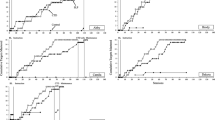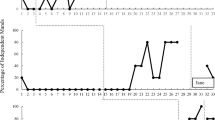Abstract
Children with autism were taught spontaneous requests through a time delay procedure. Unlike previous research, which usually employed food as the target stimuli to be requested, the present study used toy pieces from multi-component toys. The procedure involved presenting a child with the target stimulus, with the trainer prompting the child by immediately modeling the request response. When the response was imitated without error, prompting was delayed with the time interval gradually being increased over trials. A spontaneous or imitated response was reinforced by giving the child the requested object. As the stimulus/model interval increased, children with autism were expected to initiate the request by themselves prior to the prompt. The efficacy of the time delay procedure was assessed using a multiple baseline across subject design with three Chinese boys with autism. Results showed that the three children acquired a 100% performance within five to nine sessions of training and the skill was maintained at the one-month and three-month followups. Furthermore, the learned response transferred to various conditions when tested across setting, person, toy, and food items. These results suggest that toys, the multi-component ones in particular, served well as reinforcers for language training. Furthermore these findings confirmed the practical utility of the time delay procedure for promoting spontaneous communication skills in children with autism.
Similar content being viewed by others
References
Charlop, M. H., Schreibman, L., & Thibodeau, M. G. (1985). Increasing spontaneous verbal responding in autistic children using a time delay procedure.Journal of Applied Behavior Analysis, 18, 155–166.
Charlop, M. H., & Walsh, M. E. (1986). Increasing autistic children's spontaneous verbalizations of affection: An assessment of time delay and peer modeling procedures.Journal of Applied Behavior Analysis, 19, 307–314.
Goetz, L., Gee, K., & Sailor, W. (1985). Using a behavior chain interruption strategy to teach communication skills to students with severe disabilities.Journal of the Association for Persons with Severe Handicaps, 10, 21–30.
Halle, J. W., Baer, D. M., & Spradlin, J. E. (1981). Teacher's generalized use of delay as a stimulus control procedure to increase language use in handicapped children.Journal of Applied Behavior Analysis, 14, 389–409.
Halle, J. W., Marshall, A. M., & Spradlin, J. E. (1979). Time delay: A technique to increase language use and facilitate generalization in retarded children.Journal of Applied Behavior Analysis, 12, 431–439.
Howlin, P. (1989). Changing approaches to communication training with autistic children.British Journal of Disorders of Communication, 24, 151–168.
Hunt, P., & Goetz, L. (1988). Teaching spontaneous communication in natural settings through interrupted behavior chains.Topics in Language Disorders, 9, 58–71.
Lovaas, O. I., Koegel, R. L., & Schreibman, L. (1979). Stimulus overselectivity in autism: A review research.Psychological Bulletin, 86, 1236–1254.
Matson, J. L., Sevin, J. A., Fridley, D., & Love, S. R. (1990). Increasing spontaneous language in three autistic children.Journal of Applied Behavior Analysis, 23, 227–233.
Schreibman, L., & Charlop, M. H. (1981). S+ versus S-fading in prompting procedures with autistic children.Journal of Experimental Child Psychology, 31, 508–520.
Schuler, A. (1987). The role of social interaction in the development of thinking skills.Focus on Exceptional Children, 19, 1–11.
Stokes, T. F., & Baer, D. M. (1977). An implicit technology of generalization.Journal of Applied Behavior Analysis, 10, 349–367.
Wolery, M., Ault, M. J., & Doyle, P. M. (1992).Teaching students with moderate to severe disabilities: Use of response prompting procedures. New York: Longman.
Author information
Authors and Affiliations
Rights and permissions
About this article
Cite this article
Leung, J.P. Teaching spontaneous requests to children with autism using a time delay procedure with multi-component toys. J Behav Educ 4, 21–31 (1994). https://doi.org/10.1007/BF01560506
Issue Date:
DOI: https://doi.org/10.1007/BF01560506




